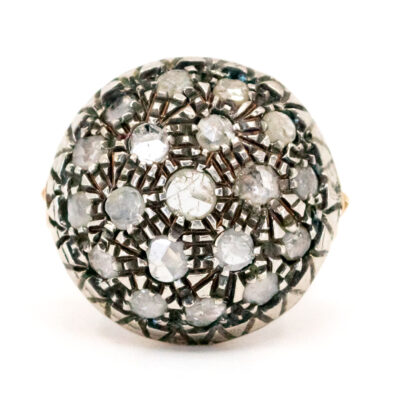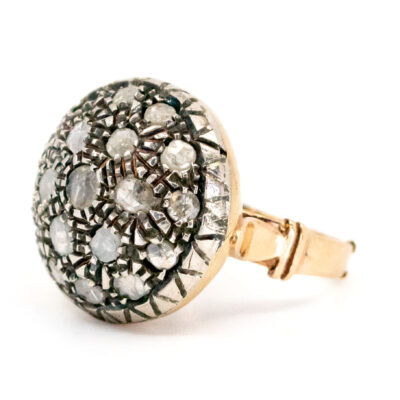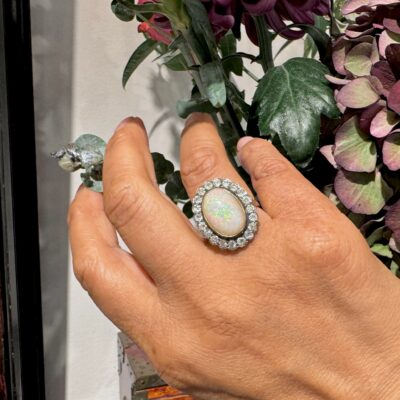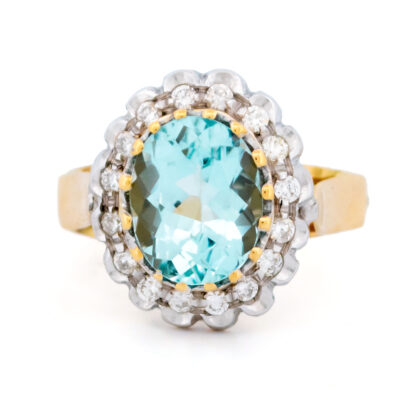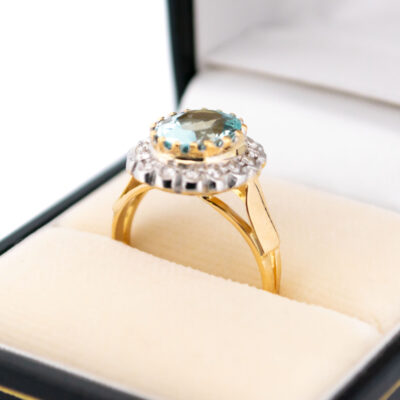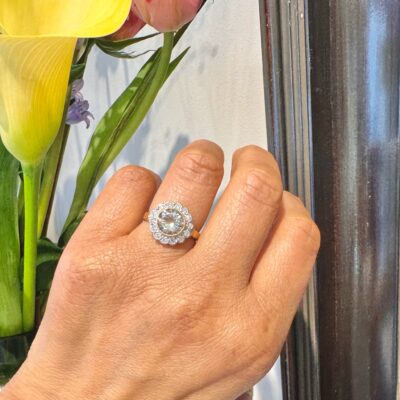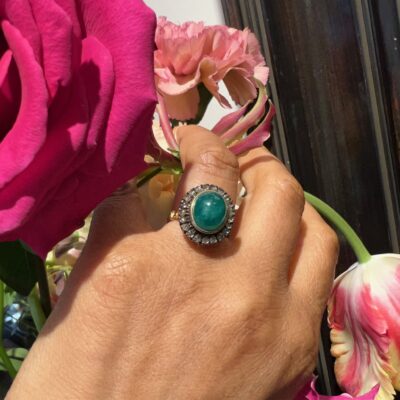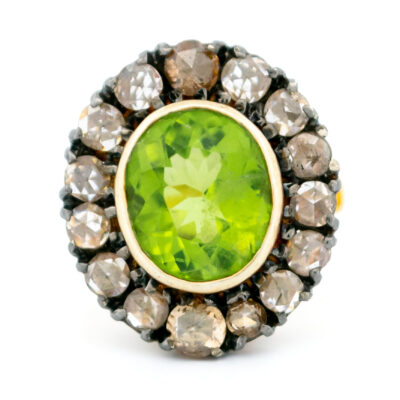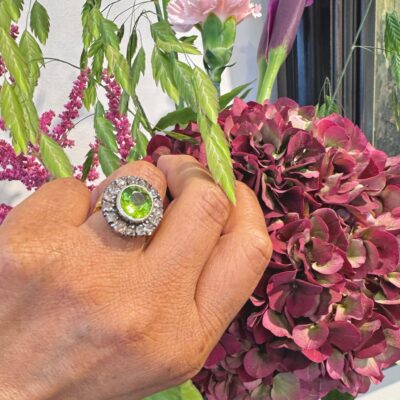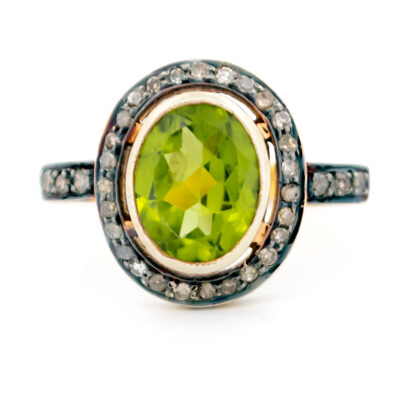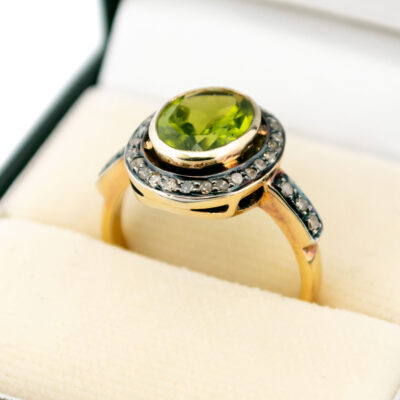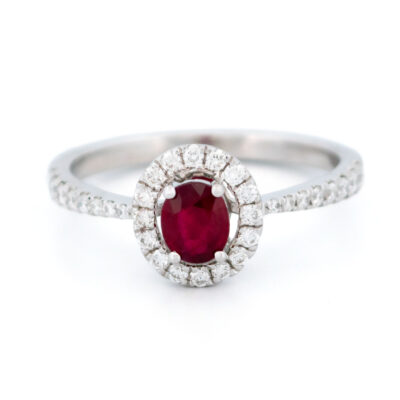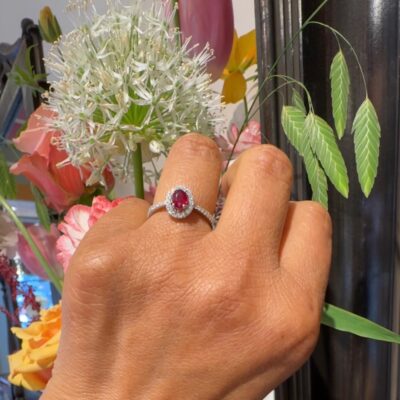This exquisite Victorian-inspired cluster ring showcases a captivating round-shaped demantoid garnet weighing approximately 0.30 carats, surrounded by a halo of sparkling brilliant-cut diamonds. All crafted in 14k gold.
Videos
Details: ±0.30ct Demantoid, Brilliant-cut diamonds, 14k Ring.
Design Era: New Victorian.
Size: 16.31 NL / 51.2 FR / 5¾ US / L UK, sizeable (Within reason. Contact seller for information).
Dimensions: H 0.4 x L 0.9 x W 0.9 cm.
Weight in grams: 2.3.
Condition: New.
Shipping and Pickup: This lovely piece ships from our store located in the center of Amsterdam, The Netherlands. We offer both registered shipping and local pickup at our store. In the case of local pickup, any applicable shipping costs will be refunded.
About Us: Add some sparkle to your style with Binenbaum.com. We offer a stunning selection of antique and vintage jewelry that you won’t find anywhere else. From timeless rings and dazzling necklaces to unique brooches, we have something for every taste and occasion. Visit our website today and treat yourself to a piece of history.
| Design Era | |
|---|---|
| Design & Historical Context | The Victorian Era spanned Queen Victoria's rule of England from 1837 until 1901. During this time, a middle class began to emerge, sparking a demand for jewelry in the mass market, jewelry trends often reflected the tone of current events. The era is usually divided into several subsections: the Romantic Period from 1837 to 1861, the Grand Period from 1861 to 1880, and the Aesthetic Period from 1880 to 1901. During the Romantic Period jewelry also featured nature-inspired designs, similar to jewelry of the Georgian era. Frequently, these designs were delicately and intricately etched into gold. Lockets and brooches were popular in daytime jewelry during the early Victorian era, whereas colored gemstones and diamonds were worn during the evening. During the Grand Period jewelry , because the Grand or Mid-Victorian era corresponded with the death of Queen Victoria's husband, many jewelry pieces have solemn, somber designs. Known as mourning jewelry, the pieces feature heavy, dark stones. Jet, onyx, amethyst, and garnet are frequently found in jewelry from this period. Compared to previous periods, Mid-Victorian-era jewelry features highly creative, colorful designs using shells, mosaics and gemstones. During the Aesthetic period, jewelers used diamonds and feminine, bright gemstones such as sapphire, peridot, and spinel. Star and crescent designs as well as elaborate hat pins were also popular. Some scholars believe the aesthetic era began sooner, in 1875, and ended as early as 1890. |
| Key Materials | |
| Materials & Craftsmanship | Demantoid: The Gem of Fiery Brilliance and Rare Beauty Demantoid, a stunning green variety of andradite garnet, is one of the most prized and rare gemstones in the world, celebrated for its exceptional brilliance and vibrant green color. Known for its high dispersion, demantoid has a fire that rivals even diamonds, giving it a captivating sparkle that sets it apart from other green gemstones. Discovered in the Ural Mountains of Russia in the mid-19th century, demantoid quickly became a favorite among the Russian aristocracy and European royalty. The name demantoid comes from the Dutch word demant, meaning diamond, a reference to its diamond-like brilliance. This gemstone was highly valued by jewelers like Carl Fabergé, who used it extensively in his exquisite creations. In modern jewelry, demantoid is sought after for its intense color, ranging from yellow-green to deep emerald, with the most desirable stones exhibiting a rich, vivid green. What makes demantoid truly unique is the presence of horsetail inclusions—fine, fibrous inclusions of byssolite—that are often seen as a hallmark of its authenticity and are particularly valued by collectors. With a Mohs hardness of 6.5 to 7, demantoid is durable enough for most types of jewelry but should be worn with some care to avoid scratching. It is often featured in rings, earrings, pendants, and brooches, where its dazzling fire can be fully appreciated. The gemstone's rarity and beauty make it a coveted choice for those looking to add a distinctive and luxurious piece to their collection. Demantoid is more than just a gemstone; it is a symbol of rarity, luxury, and exceptional brilliance. Its vivid green hue and remarkable sparkle make it an extraordinary choice for those who seek a gemstone that is both visually stunning and steeped in history. Whether set in a vintage-inspired design or a modern masterpiece, demantoid garnet is sure to captivate and enchant anyone who encounters its fiery beauty. Brilliant-cut diamond: The Pinnacle of Sparkle and Brilliance The brilliant-cut diamond is the most popular and widely recognized diamond cut in the world, renowned for its exceptional sparkle and fire. This cut, perfected over centuries, is designed to maximize the reflection of light, creating the dazzling brilliance that has made it the standard for diamonds in modern jewelry. The brilliant cut features 58 facets—33 on the crown and 25 on the pavilion—carefully arranged to capture and reflect light from every angle. The precision of these facets ensures that light entering the diamond is reflected internally and dispersed into a stunning array of colors, giving the stone its characteristic brilliance. Historically, the brilliant cut evolved from earlier cuts like the Old European and rose cuts, with advancements in diamond cutting technology and understanding of light reflection. This modern cut became widely adopted in the early 20th century and quickly became the preferred choice for engagement rings and other fine jewelry, due to its unmatched sparkle. In modern jewelry, brilliant-cut diamonds are prized for their versatility and unmatched brilliance. They are the go-to choice for engagement rings, earrings, pendants, and virtually any jewelry piece where a classic, sparkling diamond is desired. The round shape and symmetrical design make the brilliant cut ideal for showcasing the inherent beauty of the diamond, regardless of its size. A brilliant-cut diamond is more than just a gemstone; it is a symbol of timeless beauty and perfection. Its unparalleled sparkle and universal appeal make it the quintessential choice for jewelry that celebrates life's most precious moments. 14k: The Durable Choice for Everyday Elegance 14k gold is a popular and practical choice in fine jewelry, known for its durability, affordability, and beautiful color. The 14k signifies that the gold is composed of 58.3% pure gold and 41.7% alloyed metals, such as copper, silver, nickel, or zinc. This combination results in a strong and resilient material that can withstand the rigors of daily wear, making it an ideal option for those seeking both beauty and durability. Historically, gold has always been a symbol of wealth and luxury, and 14k gold strikes a perfect balance between the rich appearance of gold and the strength needed for everyday use. Because of its lower gold content compared to 18k or 24k gold, 14k gold is more affordable, making it a popular choice for a wide range of jewelry pieces. In modern jewelry, 14k gold is appreciated for its versatility and variety. It is available in several colors, each achieved by mixing gold with different metals: Yellow Gold: A classic and timeless choice, 14k yellow gold has a warm, golden hue that complements most skin tones and is well-suited for both modern and traditional designs. White Gold: Created by alloying gold with white metals like nickel or palladium, 14k white gold has a sleek, silver-like appearance. It is often rhodium-plated for added shine and is a popular choice for engagement rings and other contemporary jewelry. Rose Gold: Achieved by mixing gold with copper, 14k rose gold has a soft, pinkish hue that has gained popularity for its romantic and vintage appeal. It is a favorite for those seeking a unique and stylish alternative to traditional gold colors. 14k gold is commonly used in a wide array of jewelry, including rings, necklaces, bracelets, earrings, and watches. Its durability makes it especially suitable for pieces that are worn daily, such as wedding bands and engagement rings, where the balance between strength and beauty is crucial. 14k gold is more than just a practical choice; it is a symbol of enduring style and everyday luxury. Its ability to retain the look of gold while offering greater resistance to scratches and dents makes 14k gold a versatile and timeless option for any jewelry collection. Whether in a simple band or an elaborate design, 14k gold offers a perfect blend of elegance and durability that can be enjoyed for years to come. |
| Size | |
| Dimensions | H 0.4 x L 0.9 x W 0.9 cm |
| Gender | |
| Weight (in grams) | 2.3 |
| Condition |
By following these tips, you can enjoy your precious jewelry for many years to come.
Related Products
-
Diamond 9k Silver Cluster Ring 11052-6253
€ 1.495,00 VAT incl. (where applicable) -
Opal Diamond 14k Silver Cluster Ring 13295-8127
€ 4.695,00 VAT incl. (where applicable) -
Aquamarine Diamond 18k Cluster Ring 15788-8636
€ 3.295,00 VAT incl. (where applicable) -
Aquamarine Diamond 14k Cluster Ring 12955-8079
€ 2.295,00 VAT incl. (where applicable) -
Emerald Diamond 14k Silver Cluster Ring 12730-8008
€ 3.495,00Original price was: € 3.495,00.€ 3.195,00Current price is: € 3.195,00. VAT incl. (where applicable) -
Peridot Diamond 14k Silver Cluster Ring 14609-8378
€ 3.695,00 VAT incl. (where applicable) -
Diamond Peridot 14k Silver Cluster Ring 14610-8379
€ 1.995,00 VAT incl. (where applicable) -
Diamond Ruby 18k Cluster Ring 16728-8963
€ 1.995,00 VAT incl. (where applicable)
- Home
- Collection
- Fine Jewelry
- Silver Jewelry
- Silverware
- Boxes
- Candlesticks
- Salt and pepper shakers
- Miniatures
- Salt cellars
- Spoon Set
- Condiments
- Frames
- Napkin Ring
- Spoon
- Oddities
- Cups
- Vases
- Cutlery
- Serving Spoon And Cake Server
- Candlesticks
- Baskets
- Hanukkiah
- Spice Tower
- Yad
- Tea Set
- Sugar Castor
- Napkin Rings
- Wine Bottle Coaster
- Wine Stopper
- Tea Pot
- Jugs
- Rattles
- Hip Flask
- Miscellaneous
- Rings 💍
- About
- Contact







